Ship-Based Measurements of Atmospheric Mercury Concentrations over the Baltic Sea
Abstract
:1. Introduction
1.1. Current State of Research
1.2. Aim and Conclusion
2. Method
2.1. Mercury Analyser
2.2. Softwares
3. Results and Discussion
3.1. Anthropogenic Sources
3.2. Observations from the Plots
3.2.1. Cruise North
3.2.2. Bothnian Bay
3.2.3. Cruise South
3.3. Comparisons and Other Observations
4. Conclusions
Supplementary Materials
Acknowledgements
Author Contributions
Conflicts of Interest
References
- UNEP. Global Mercury Assessment 2013: Sources, Releases and Environmental Transport; UNEP Chemicals Branch: Geneva, Switzerland, 2013. [Google Scholar]
- Sunderland, E.M.; Chmura, G.L. The history of mercury emissions from fuel combustion in Maritime Canada. Environ. Pollut. 2000, 110, 297–306. [Google Scholar] [CrossRef]
- Pirrone, N.; Mahaffey, K.R. Where we stand on mercury pollutution and its health effects on regional and global scales. I. In Dynamics of Mercury Pollution on Regional and Global Scales: Atmospheric Processes and Human Exposures around the World; Pirrone, N., Mahaffey, K.R., Eds.; Springer Science, Buisness Media Inc.: New York, NY, USA, 2005. [Google Scholar]
- World Health Organization. Mercury and Health; World Health Organization: Geneva, Switzerland, 2017; Available online: http://www.who.int/mediacentre/factsheets/fs361/en/ (accessed on 24 November 2017).
- Harada, M. Minamata Disease: Methylmercury Poisoning in Japan Caused by Environmental Pollution. Crit. Rev. Toxicol. 2008, 25, 1–24. [Google Scholar] [CrossRef] [PubMed]
- Tekran Instruments Corporation. Mercury Science. Mercury in the Environment; Tekran Instruments Corporation: Toronto, ON, Canada, 2017; Available online: http://www.tekran.com/mercury-science/mercury-in-the-environment/ (accessed on 24 November 2017).
- Naturvårdsverket. Utsläpp i Siffror. 2016. Available online: http://utslappisiffror.naturvardsverket.se/ (accessed on 24 November 2017).
- Cole, A.S.; Steffen, A.; Pfaffhuber, K.A.; Berg, T.; Pilote, M.; Poissant, L.; Tordon, R.; Hung, H. Ten-year trends of atmospheric mercury in the high Arctic compared to Canadian sub-Arctic and mid-latitude sites. Atmos. Chem. Phys. 2013, 13, 1535–1545. [Google Scholar] [CrossRef] [Green Version]
- Fu, X.W.; Feng, X.; Dong, Z.Q.; Yin, R.S.; Wang, J.X.; Yang, Z.R.; Zhang, H. Atmospheric gaseous elemental mercury (GEM) concentrations and mercury depositions at a high-altitude mountain peak in south China. Atmos. Chem. Phys. 2010, 10, 2425–2437. [Google Scholar] [CrossRef]
- Nerentorp, M. Mercury Cycling in the Global Marine Environment. Ph.D. Thesis, Chalmers University of Technology, Gothenburg, Sweden, 2016. [Google Scholar]
- Gårdfeldt, K. Kvicksilver Från Havet. 2001. Available online: https://www.havet.nu/dokument/HU20012kvicksilver.pdf (accessed on 24 November 2017).
- Steffen, A.; Douglas, T.; Amyot, M.; Ariya, P.; Aspmo, K.; Berg, T.; Bottenheim, J.; Brooks, S.; Cobbett, F.; Dastoor, A.; et al. A synthesis of atmospheric mercury depletion event chemistry in the atmosphere and snow. Atmos. Chem. Phys. 2008, 8, 1445–1482. [Google Scholar] [CrossRef] [Green Version]
- Nerentorp, M.; Kyllonen, K.; Wängberg, I.; Kuronen, P. Speciation measurements of airborne mercury species in northern Finland; Evidence for long range transport of air masses depleted in mercury. In Proceedings of the 16th International Conference on Heavy Metals in the Environment, Rome, Italy, 23–27 September 2012; EDP Sciences: Paris, France, 2013. [Google Scholar]
- Sprovieri, F.; Pirrone, N.; Bencardino, M.; D’Amore, F.; Carbone, F.; Cinnirella, S.; Mannarino, V.; Landis, M.; Ebinghaus, R.; Weigelt, A.; et al. Atmospheric mercury concentrations observed at ground-based monitoring sites globally distributed in the framework of the GMOS network. Atmos. Chem. Phys. 2016, 10, 11915–11935. [Google Scholar] [CrossRef]
- Angot, H.; Dastoor, A.; Simone, F.; Gårdfeldt, K.; Gencarelli, C.N.; Hedgecock, I.M.; Langer, S.; Magand, O.; Mastromonaco, M.N.; Nordstrøm, C.; et al. Chemical cycling and deposition of atmospheric mercury in polar regions: Review of recent measurements and comparison with models. Atmos. Chem. Phys. 2016, 16, 10735–10763. [Google Scholar] [CrossRef] [Green Version]
- Sprovieri, F.; Pirrone, N.; Ebinghaus, R.; Kock, H.; Dommergue, A. A review of worldwide atmospheric mercury measurements. Atmos. Chem. Phys. 2010, 10, 8245–8265. [Google Scholar] [CrossRef] [Green Version]
- United Nations Environment. Convention; United Nations Environment: Geneva, Switzerland, 2017; Available online: http://www.mercuryconvention.org/Convention/tabid/3426/language/en-US/Default.aspx (accessed on 24 November 2017).
- Global Mercury Observation System. Available online: http://www.gmos.eu/index.php/groud-based (accessed on 24 November 2017).
- Wängberg, I.; Schmolke, S.; Schager, P.; Munthe, J.; Ebinghaus, R.; Iverfeldt, Å. Estimates of air-sea exchange of mercury in the Baltic Sea. Atmos. Environ. 2001, 35, 5477–5484. [Google Scholar] [CrossRef]
- Kentisbeer, J.; Leaver, D.; Cape, J.N. An analysis of total gaseous mercury (TGM) concentrations across the UK from a rural sampling network. J. Environ. Monit. 2011, 13, 1653–1661. [Google Scholar] [CrossRef] [PubMed] [Green Version]
- Ebinghaus, R.; Kock, H.H.; Coggins, A.M.; Spain, T.G.; Jennings, S.G.; Temme, C. Long-term measurements of atmospheric mercury at Mace Head, Irish west coast, between 1995 and 2001. Atmos. Environ. 2002, 36, 5267–5276. [Google Scholar] [CrossRef]
- Slemr, F. Trends in atmospheric mercury concentrations over the Atlantic Ocean and the Wank summit and the resulting constraints on the budget of atmospheric mercury. I. In Global and Regional Mercury Cycles: Sources, Fluxes and Mass Balances; NATO ASI Series; Baeyens, W., Ebinghaus, R., Vasiliev, O., Eds.; Kluwer: Dordrecht, The Netherlands, 1996; pp. 33–84. [Google Scholar]
- Brosset, C. Total airborne mercury and its possible origin. In Water, Soil and Air Pollution; Springer: Berlin/Heidelberg, Germany, 1982; Volume 17, pp. 37–50. [Google Scholar]
- Swedish Maritime Administration. Isbrytaren/Forskningsfartyget Oden; Swedish Maritime Administration: Norrköping, Sweden, 2016. Available online: http://sjofartsverket.se/oden (accessed on 24 November 2017).
- Fonselius, S.; Eklund, R.; Warell, J.; Strömberg, J.O. Östersjön. I: NE Nationalencyklopedin. Malmö. Available online: http://www.ne.se/uppslagsverk/encyklopedi/l%C3%A5ng/%C3%B6stersj%C3%B6n (accessed on 24 November 2017).
- Swedish Meteorological and Hydrological Insitute. Havsis; Swedish Meteorological and Hydrological Insitute: Norrköping, Sweden, 2018. Available online: http://www.smhi.se/klimatdata/oceanografi/havsis (accessed on 24 November 2017).
- Tekran Instruments Corporation. The NEW Tekran® 2537X Automated Ambient Air Analyzer; Tekran Instruments Corporation: Toronto, ON, Canada, 2018; Available online: http://www.tekran.com/products/ambientair/tekran-model-2537-cvafs-automated-mercury-analyzer/ (accessed on 24 November 2017).
- Tekran Instruments Corporation. Tekran Manual: Model 2537A Mercury Vapour Analyzer User Manual; Tekran Instruments Corporation: Toronto, ON, Canada, 1997. [Google Scholar]
- Schlitzer, R. Ocean Data View. 2017. Available online: http://odv.awi.de (accessed on 24 November 2017).
- Ocean Data View Homepage. Bremerhaven: Alfred Wegener Institute for Polar and Marine Research. 2017. Available online: https://odv.awi.de/ (accessed on 24 November 2017).
- Rolph, G.; Stein, A.; Stunder, B. Real-time Environmental Applications and Display System: READY. Environ. Model. Softw. 2017, 95, 210–228. [Google Scholar] [CrossRef]
- Description. National Oceanic and Atmospheric Administration Air Resources Laboratory: College Park, MD, USA, 2016. Available online: http://www.arl.noaa.gov/HYSPLIT_info.php (accessed on 24 November 2017).
- The Geological Survey of Finland. Metals and Minerals Production; The Geological Survey of Finland: Espoo, Finland, 2016; Available online: http://en.gtk.fi/informationservices/mineralproduction/ (accessed on 24 November 2017).
- Euro Chlor Mercury Emissions per Production Site. Euro Chlor: Europe. 2015. Available online: http://www.eurochlor.org/media/105938/mercury_emission_per_production_site.pdf (accessed on 24 November 2017).
- Atmospheric Emissions of Heavy Metals in the Baltic Sea Region. 2016. Available online: http://helcom.fi/baltic-seatrends/environment-fact-sheets/hazardous-substances/atmospheric-emissions-of-heavymetals-in-the-baltic-sea-region/ (accessed on 24 November 2017).
- Horowitz, H.M.; Jacob, D.J.; Zhang, Y.; Dibble, T.S.; Slemr, F.; Amos, H.M.; Schmidt, J.A.; Corbitt, E.S.; Marais, E.A.; Sunderland, E.M. A new mechanism for atmospheric mercury redox chemistry: Implications for the global mercury budget. Atmos. Chem. Phys. 2017, 17, 6353–6371. [Google Scholar] [CrossRef]
- Kuss, J. Water—Air gas exchange of elemental mercury: An experimentally determined mercury diffusion coefficient for Hg0 water—Air flux calculations. Limnol. Oceanogr. 2014, 59, 1461–1467. [Google Scholar] [CrossRef]
- Wurl, O.; Nausch, G.; Nausch, M.; Pinxteren, M.V.; Kuss, J.; Loick-Wilde, N. Biochemical Processes in Upwelling Zones of the Baltic Sea; METEOR-Berichte; TIB: Hannover, Germany, 2016. [Google Scholar]
- Kuss, J.; Krüger, S.; Ruickholdt, J.; Wlost, K.-P. High-resolution measurements of elemental mercury in surface water for an improved quantitative understanding of the Baltic Sea as a source of atmospheric mercury. Atmos. Chem. Phys. 2017. [Google Scholar] [CrossRef]
- Wängberg, I.; Nerentorp Mastromonaco, M.G.; Munthe, J.; Gårdfeldt, K. Airborne mercury species at the Råö background monitoring site in Sweden: Distribution of mercury as an effect of long-range transport. Atmos. Chem. Phys. 2016, 16, 13379–13387. [Google Scholar] [CrossRef]
- Kentisbeer, J.; Leeson, S.R.; Clark, T.; Malcolm, H.M.; Cape, J.N. Influences and patterns in total gaseous mercury (TGM) at Harwell, England. Environ. Sci. Process. Impacts 2015, 17, 586–595. [Google Scholar] [CrossRef] [PubMed] [Green Version]
- Berg, T.; Bartnicki, J.; Munthe, J.; Lattila, H.; Hrehoruk, J.; Mazur, A. Atmospheric mercury species in the European Arctic: Measurements and modelling. Atmos. Environ. 2001, 35, 2569–2582. [Google Scholar] [CrossRef]
- Zhang, Y.; Jacob, D.J.; Horowitz, H.M.; Chen, L.; Amos, H.M.; Krabbenhof, D.P.; Slemr, F.; Louis, V.L.S.; Sunderland, E.M. Observed decrease in atmospheric mercury explained by global decline in anthropogenic emissions. Proc. Natl. Acad. Sci. USA 2016, 133, 526–531. [Google Scholar] [CrossRef] [PubMed]
- Weigelt, A.; Ebinghaus, R.; Manning, A.J.; Derwent, R.G.; Simmonds, P.G.; Spain, T.G.; Jennings, S.G.; Slemr, F. Analysis and interpretation of 18 years of mercury observations since 1996 at Mace Head, Ireland. Atmos. Environ. 2015, 100, 85–93. [Google Scholar] [CrossRef]
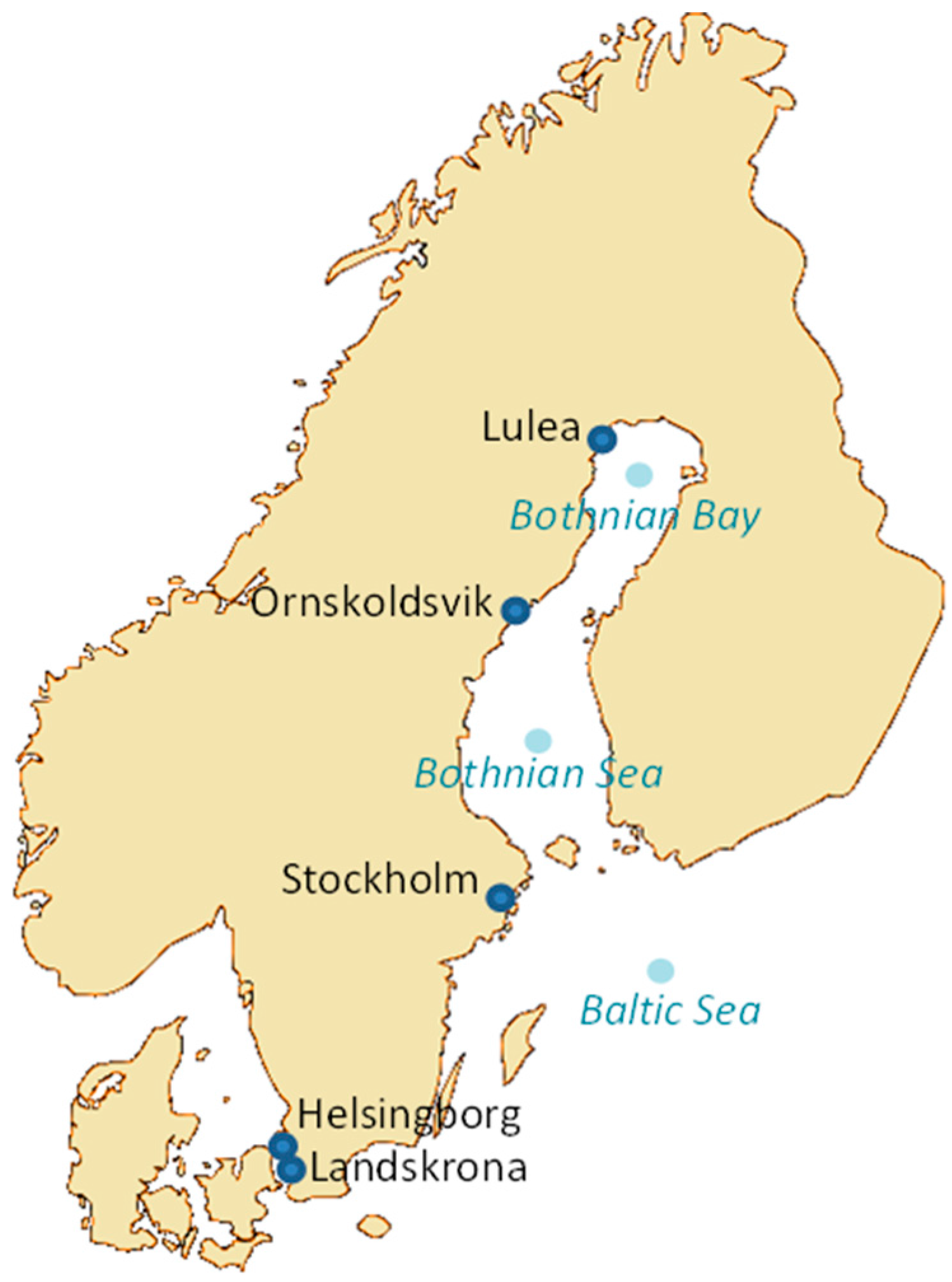
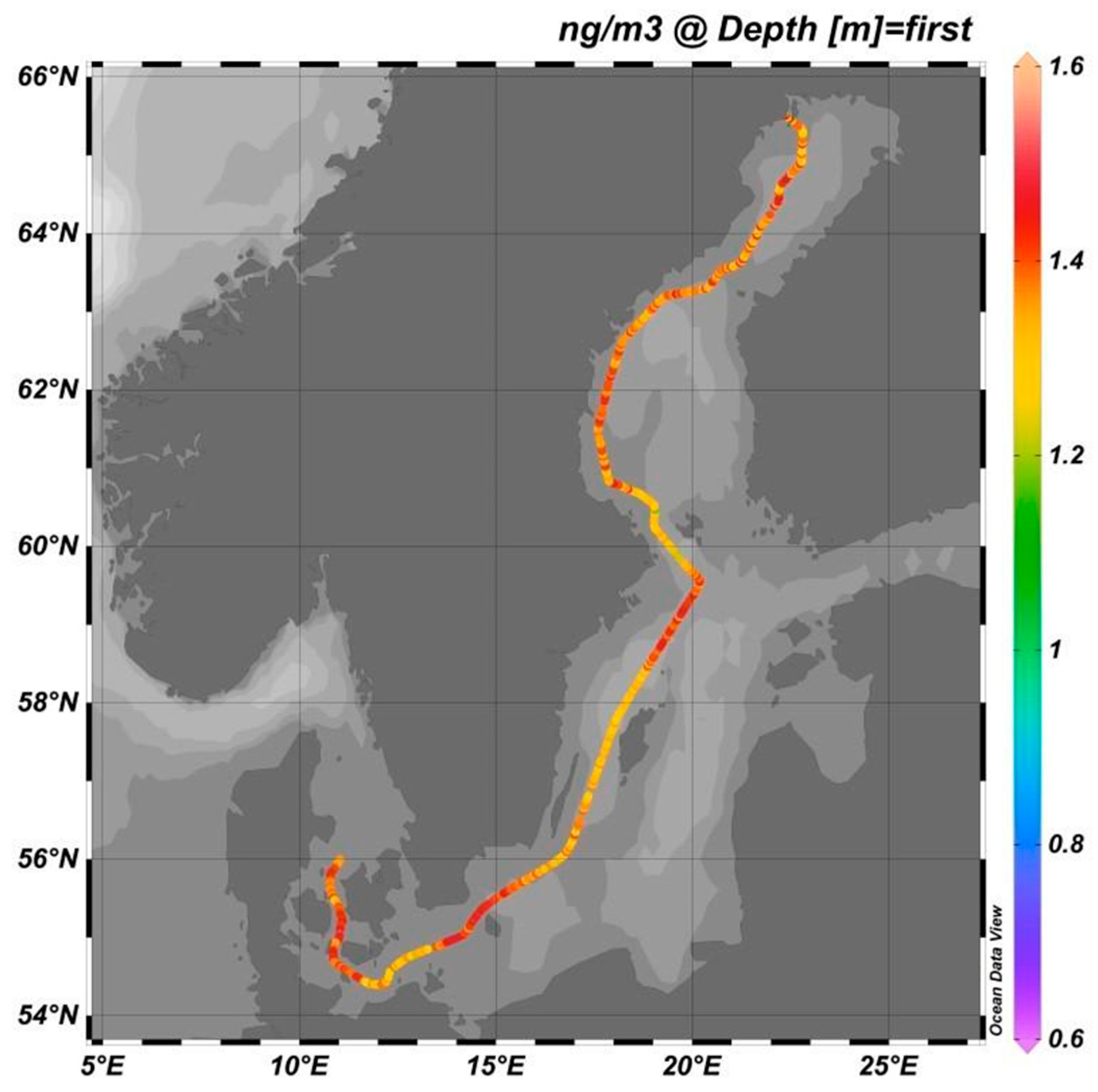

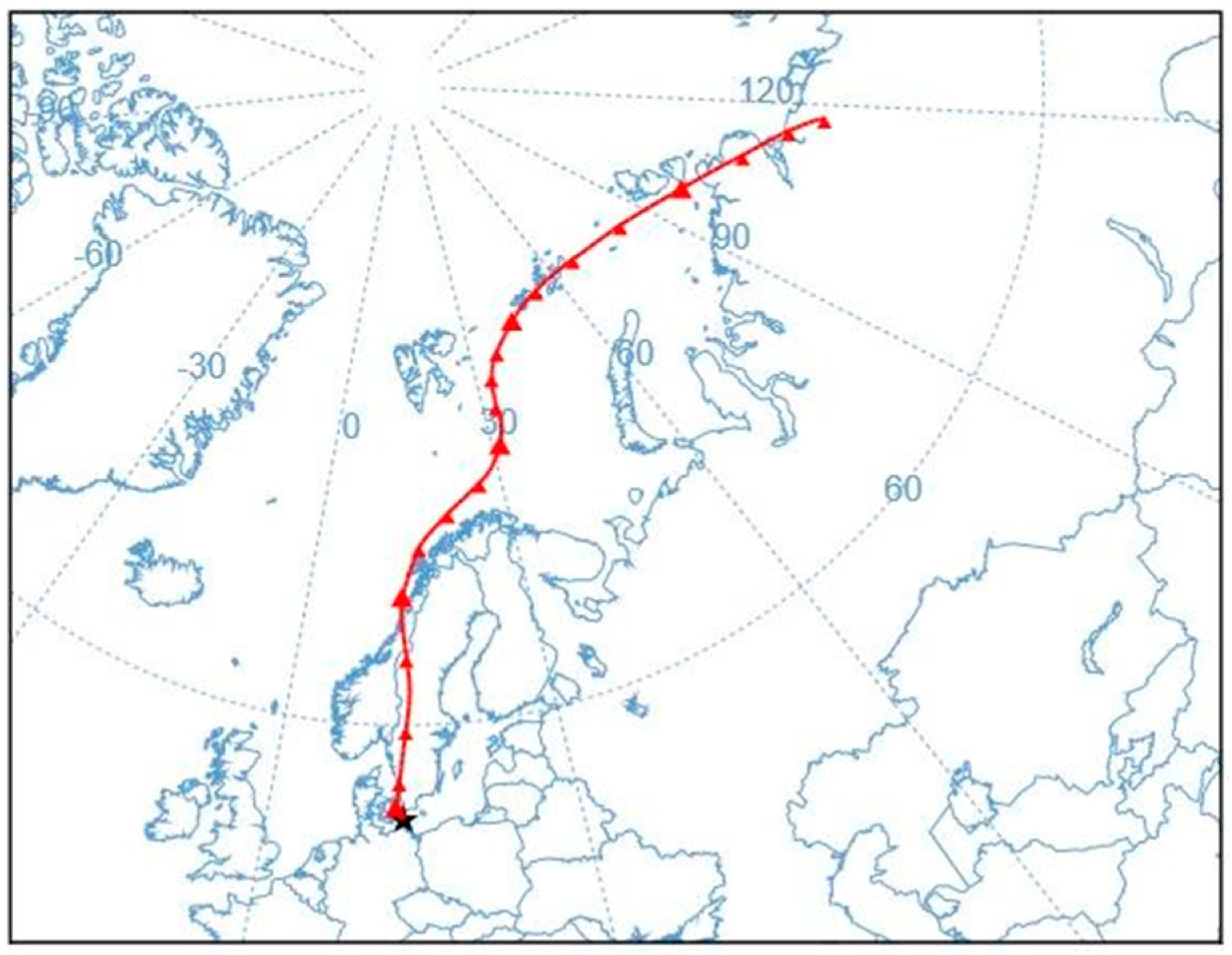
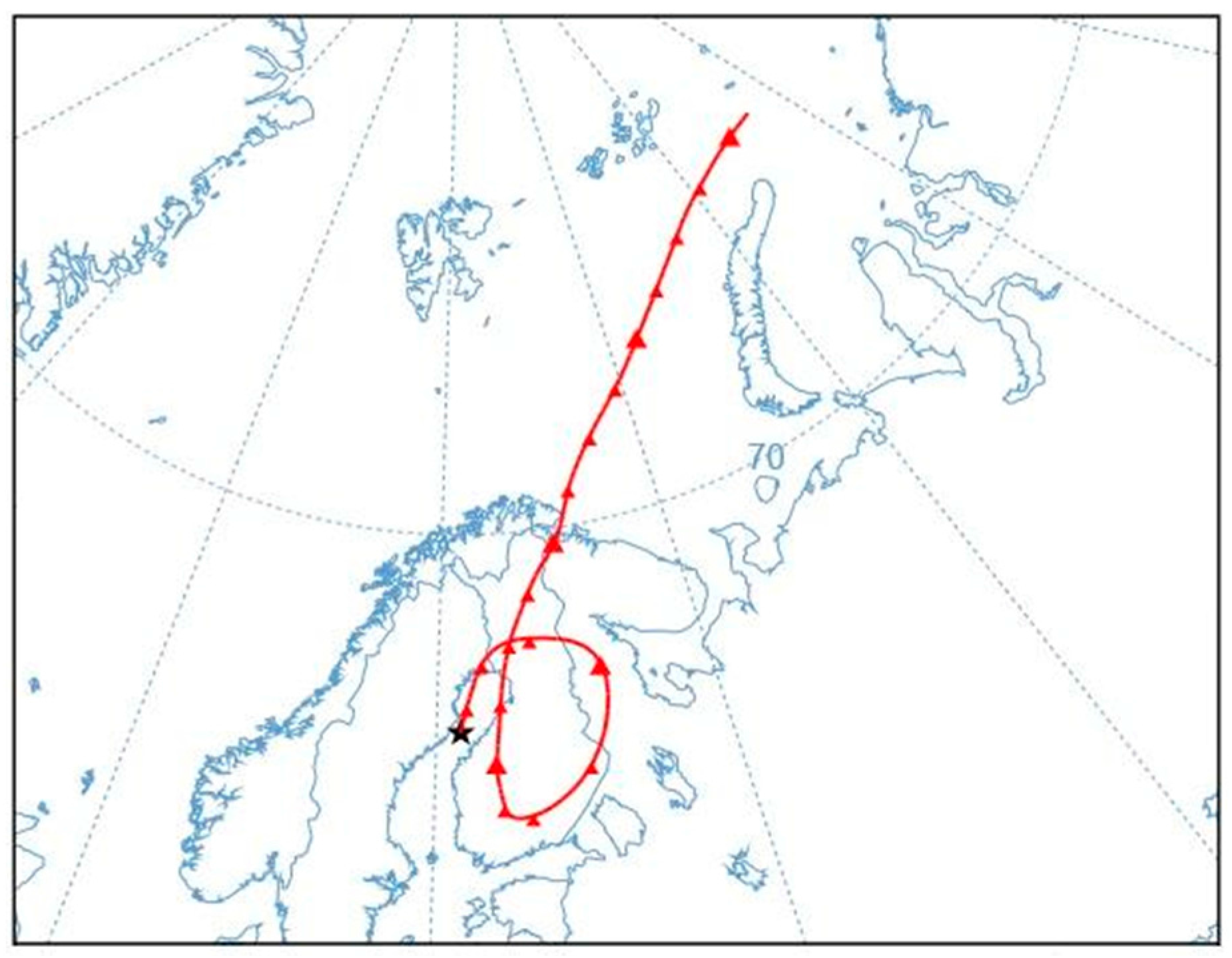

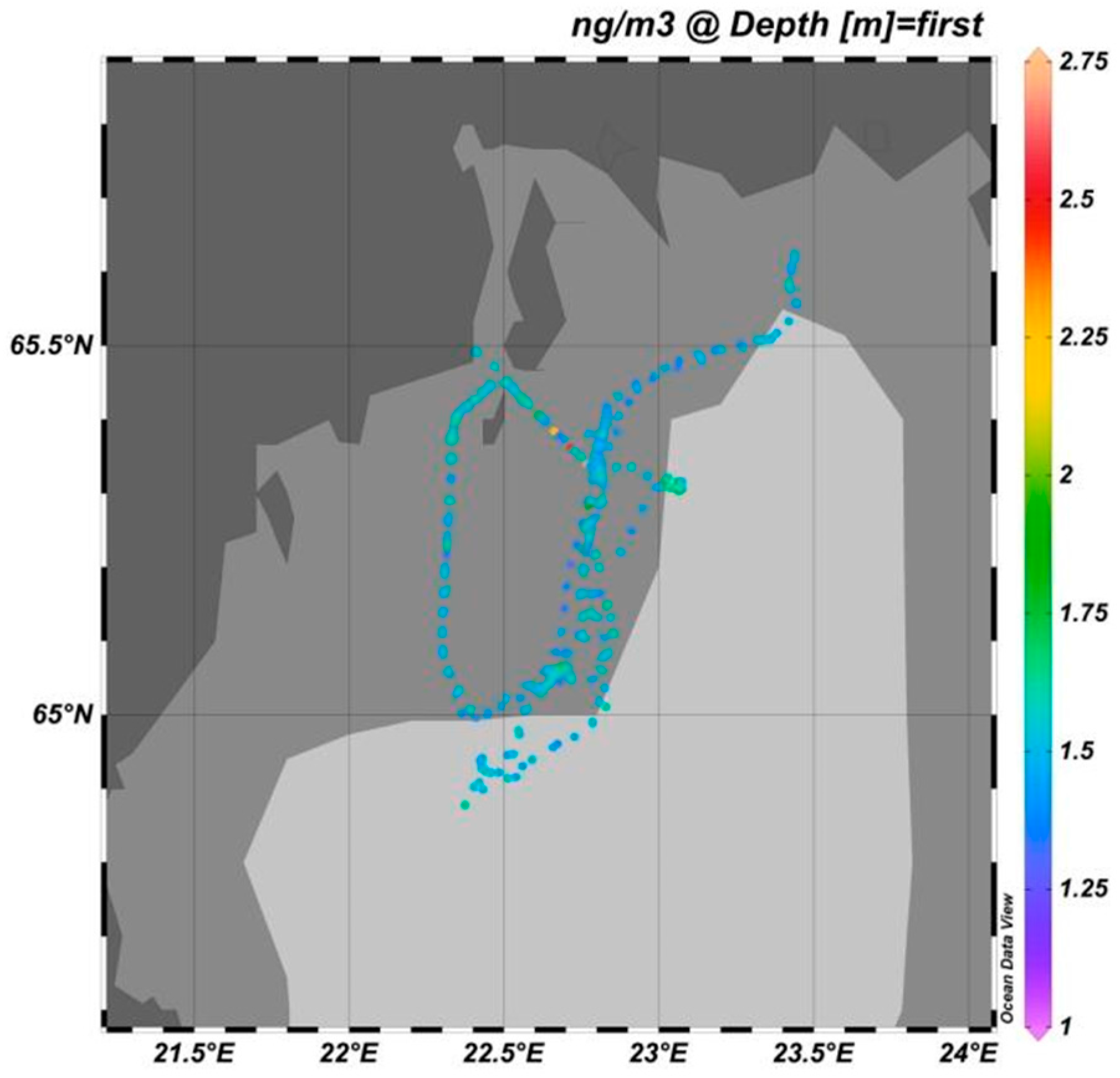

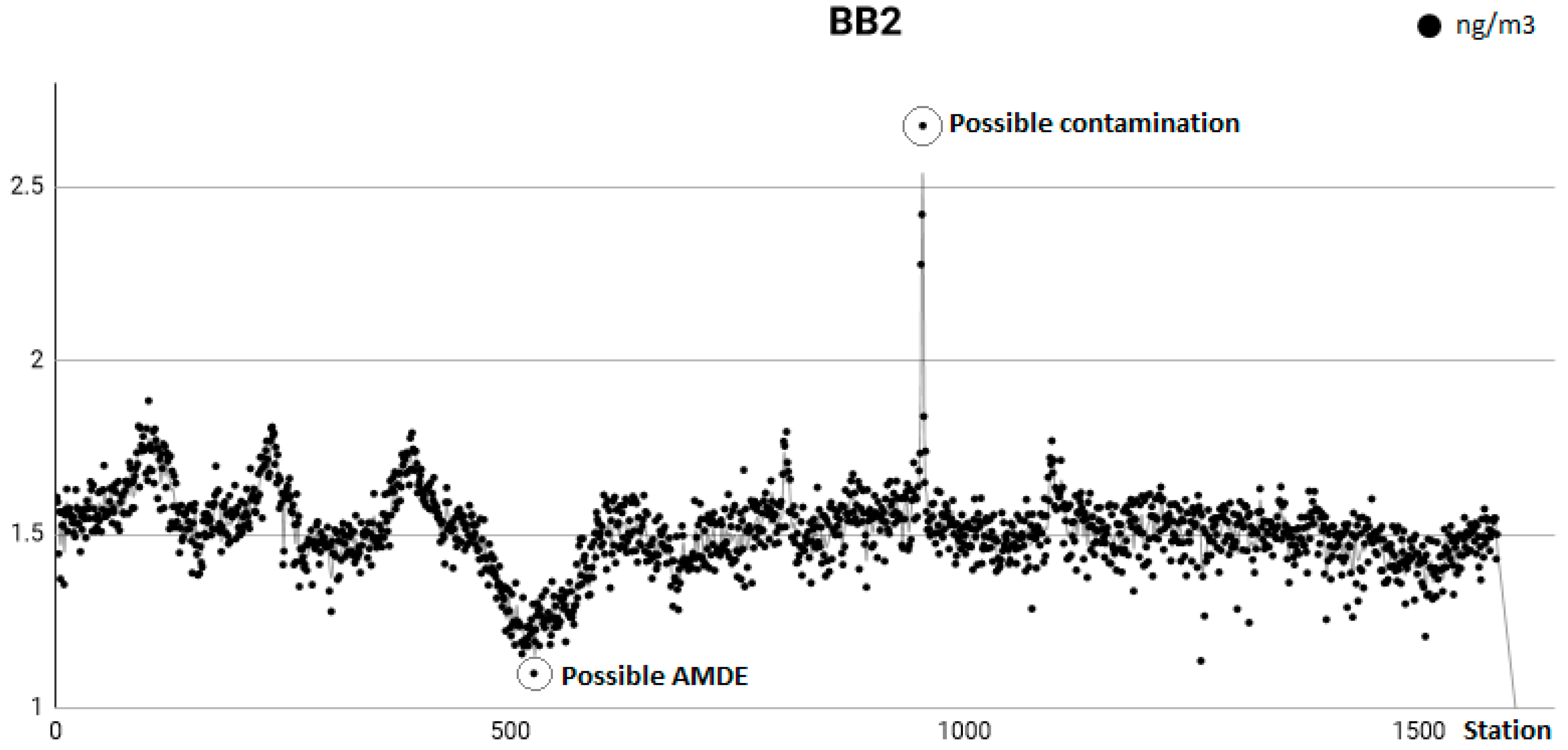
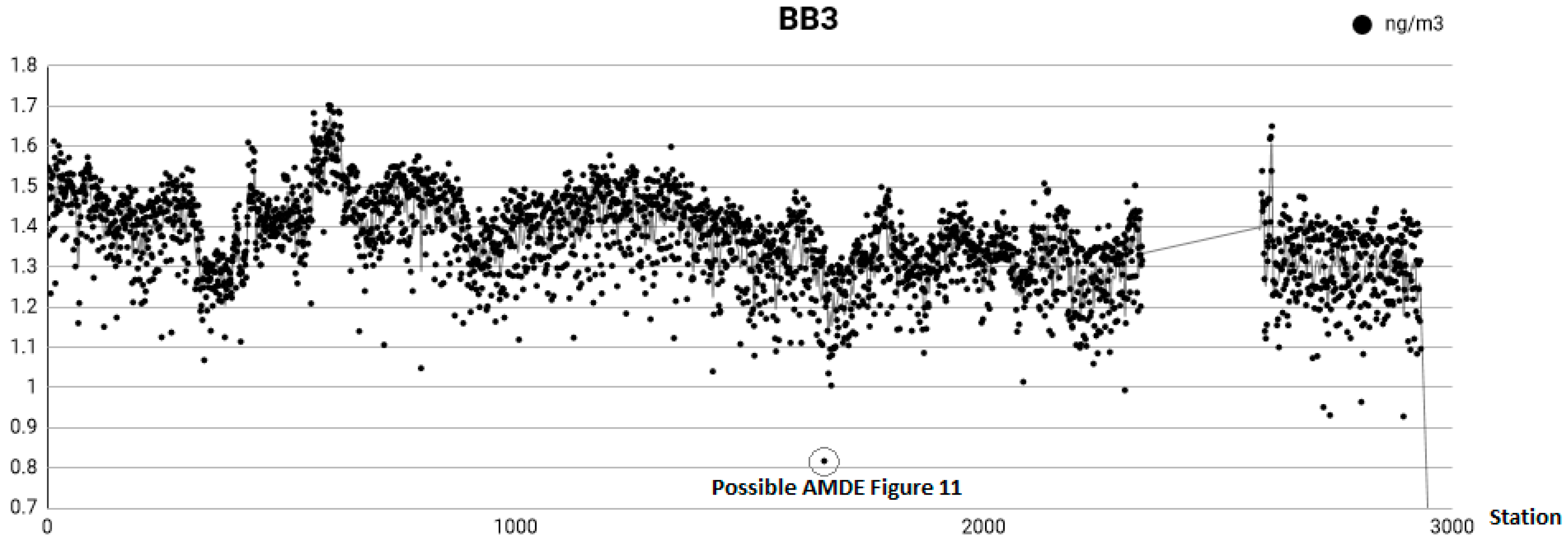

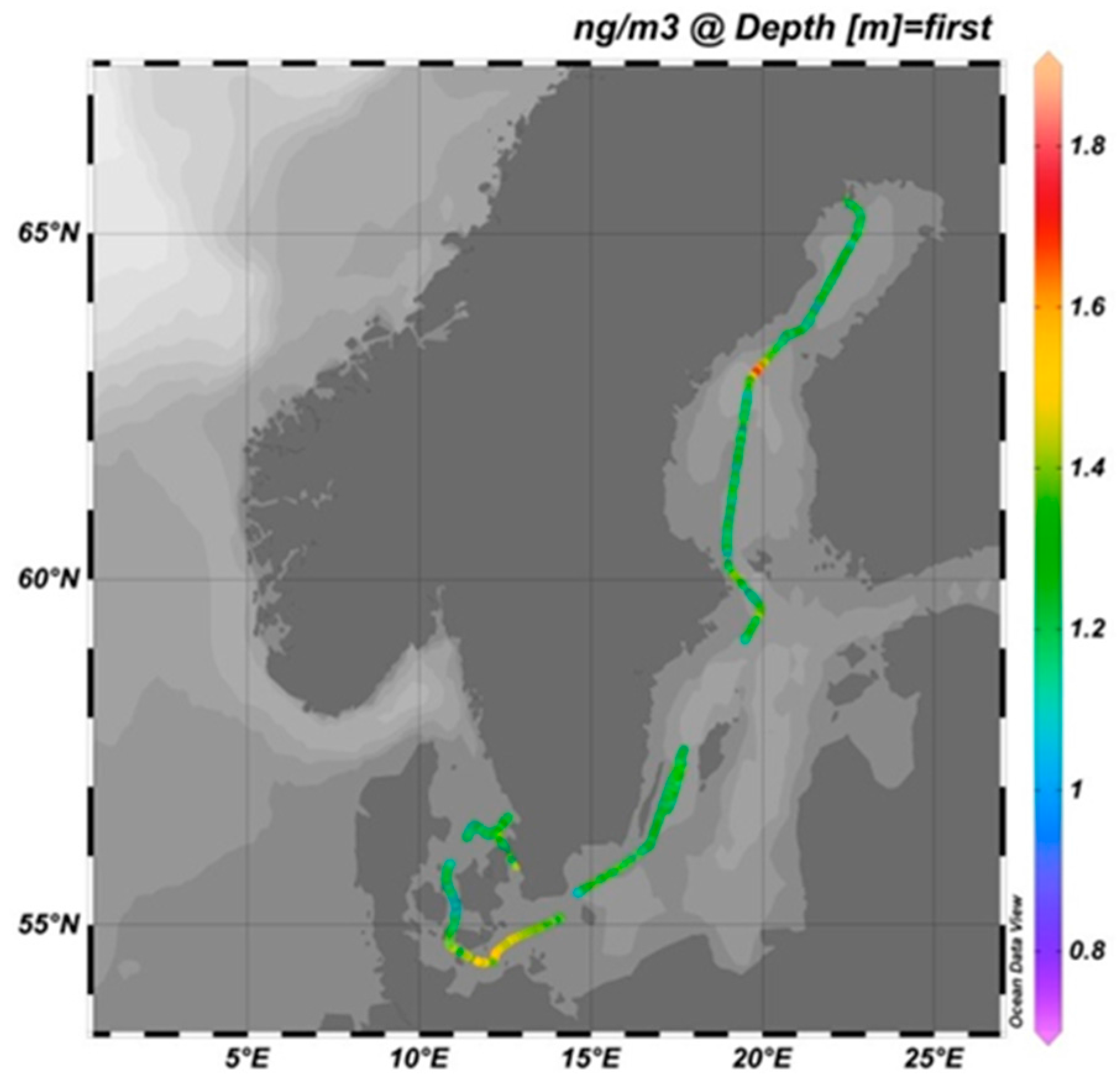
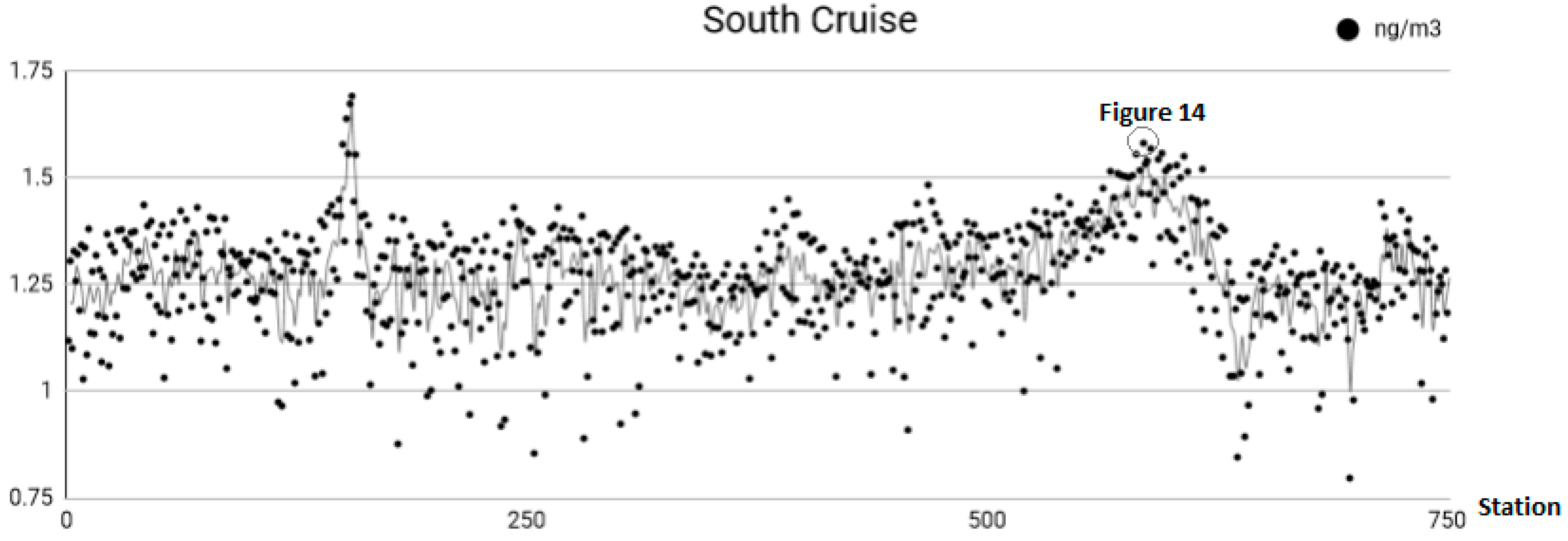
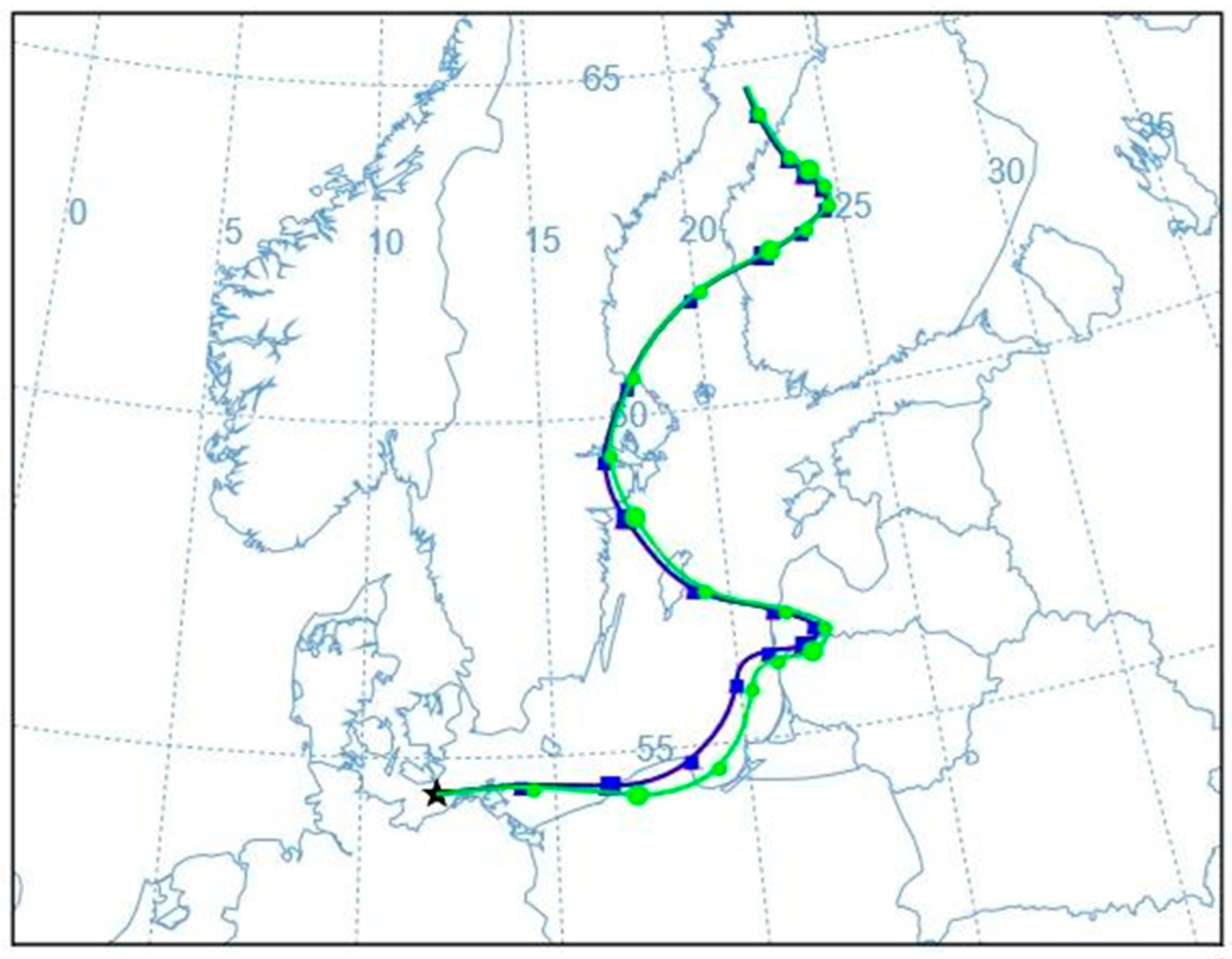

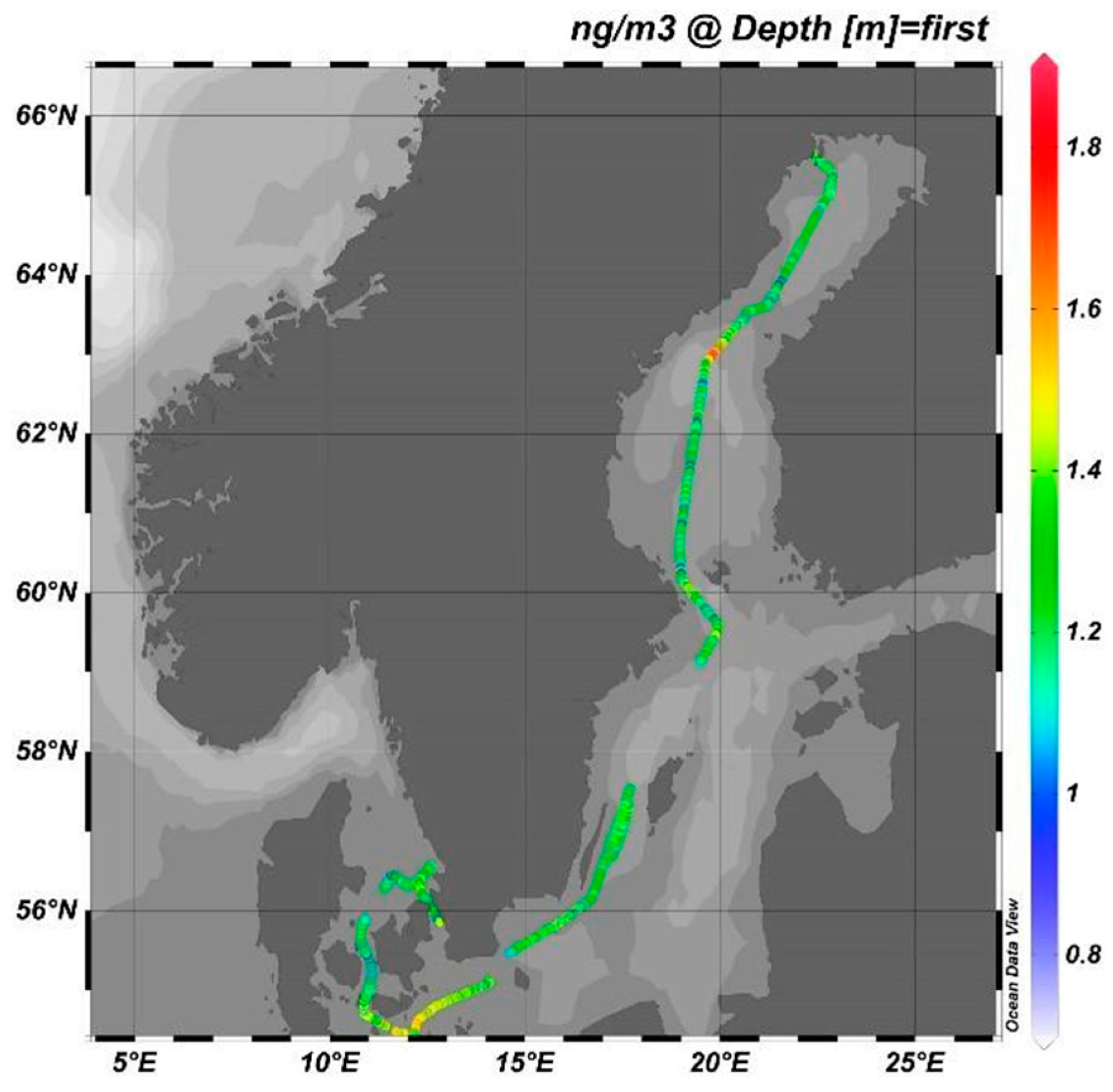
| Site | Season | GEM (ng/m3) | Range (Low-High, ng/m3) |
|---|---|---|---|
| Cruise North | Winter (2–6 December) | 1.36 ± 0.054 | 1.161–1.508 |
| Bothnian Bay (1) | Spring (13–22 March) | 1.16 ± 0.11 | 0.821–1.595 |
| Bothnian Bay (2) | Spring (23 March–5 April) | 1.51 ± 0.12 | 1.100–2.675 |
| Bothnian Bay (3) | Spring (6–27 April) | 1.36 ± 0.11 | 0.817–1.703 |
| Cruise South | Spring (28 April–5 May) | 1.29 ± 0.14 | 0.797–1.839 |
| All cruises | December 2016–May 2017 | 1.36 ± 0.16 | 0.817–2.675 |
| Location | Time Period | TGM (ng/m3) | Reference |
|---|---|---|---|
| Baltic Sea | Summer 1997 | 1.70 ± 0.20 | Wängberg et al. [19] |
| Baltic Sea | Winter 1998 | 1.38 ± 0.13 | Wängberg et al. [19] |
| Råö, Sweden | 2012–2015 | 1.42 ± 0.20 | Wängberg et al. [40] |
| Ny-Ålesund, Norway | 2015 | 1.49 ± 0.21 | Angot et al. [15] |
| Arctic | 2011–2014 | 1.46 ± 0.33 | Angot et al. [15] |
| Harwell, England | 2013 | 1.45 ± 0.24 | Kentisbeer et al. [41] |
| South China | May 2008–May 2009 | 2.80 ± 1.51 | Fu et al. [9] |
| Pallas, Finland | 1996–1997 | 1.26 | Berg et al. [42] |
| Ny-Ålesund, Norway | 1996–1997 | 1.43 | Berg et al. [42] |
| Hoburg, Sweden | 1979–1980 | 3.91 ± 1.15 | Brosset C. [23] |
| Mace Head, Ireland | Summer 1995–2001 | 1.6 | Ebinghaus et al. [21] |
| Mace Head, Ireland | Winter 1995–2001 | 1.9 | Ebinghaus et al. [21] |
© 2018 by the authors. Licensee MDPI, Basel, Switzerland. This article is an open access article distributed under the terms and conditions of the Creative Commons Attribution (CC BY) license (http://creativecommons.org/licenses/by/4.0/).
Share and Cite
Hoglind, H.; Eriksson, S.; Gardfeldt, K. Ship-Based Measurements of Atmospheric Mercury Concentrations over the Baltic Sea. Atmosphere 2018, 9, 56. https://doi.org/10.3390/atmos9020056
Hoglind H, Eriksson S, Gardfeldt K. Ship-Based Measurements of Atmospheric Mercury Concentrations over the Baltic Sea. Atmosphere. 2018; 9(2):56. https://doi.org/10.3390/atmos9020056
Chicago/Turabian StyleHoglind, Hanna, Sofia Eriksson, and Katarina Gardfeldt. 2018. "Ship-Based Measurements of Atmospheric Mercury Concentrations over the Baltic Sea" Atmosphere 9, no. 2: 56. https://doi.org/10.3390/atmos9020056




